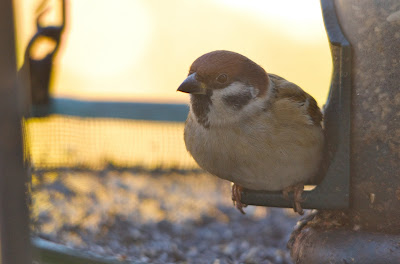
Way back in the last century, when I used to work for a living (as compared with playing for a living as I do now), I came to St. Louis on business—and birding as was my want. St Louis was, and still is to a degree, the only place in the country where a birder can find the Eurasian Tree Sparrow.
A lot of mysteries surround the diminutive bird, the greatest for me is why the bird does not expand beyond its current range. Twenty years ago there was an article in the American Birding Association newsletter about the sparrow and how to locate it within a well-defined neighborhood in St. Louis. As luck would have it I was going to St. Louis that very week so the newsletter was on top of my business papers.
I recall that wintery day when I first saw the bird. Most of the streets in what I now know as the Dog Town area are one way. Piles of snow hampered travel. I was not to be denied. I eventually parked and walked the neighborhood until I finally spotted a flock of sparrows on a backyard feeder. As I was studying the bird, a resident of the house came out and I thought I’d have some explaining to do.
Turns out the man was quite friendly. He asked me where I was from, then looked up “Medina, Ohio” in a large notebook he was carrying. No one from Medina in his book. I was a “lifer” for him! He’d been ticking off birders for years, he said.
We talked about the birds for a while, then I had to go. He seemed equally as happy that I had seen the Eurasian Tree Sparrow.
How the bird got to St Louis is not a mystery. In the 19th century, south St. Louis was the home of many European immigrants who wanted to see familiar birds from their homeland. So, on April 25, 1870, 12 Eurasian Tree Sparrows were released in Lafayette Park in south St. Louis. Numbers of other European birds were also released (European Goldfinches, Eurasian Bullfinches, Chaffinches, Greenfinches, and Linnets), but only the Eurasian Tree Sparrow successfully established a breeding population.
The birds have expanded their territory, however, not as fast or as far as one might expect of non-native bird. Since my wife hails from St. Louis and many of her relatives still live here, our trips to the area always include a search for the sparrow. It’s not a physically remarkable bird, only rare—which makes it remarkable, I guess. In that silent language birders often adopt, Susan, while talking on the phone, got my attention by clicking her fingers. I looked up from the book I was reading and she was pointing to the bushes in her mother’s suburban backyard. There sat a Eurasian Tree Sparrow! The search for the bird this year was the easiest ever.


2 comments:
A great holiday gift for the little Eurasian Sparrow as well as your relatives might be a heater for the watering station. Looks like the little guy could skate on the pond.
Lovely picture!
Post a Comment